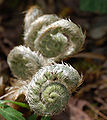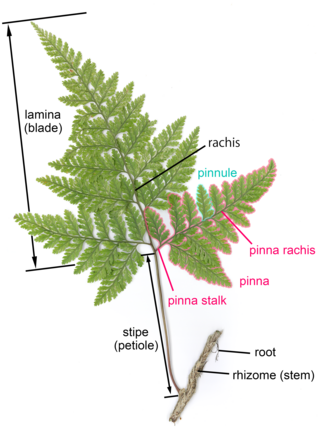
A frond is a large, divided leaf. In both common usage and botanical nomenclature, the leaves of ferns are referred to as fronds and some botanists restrict the term to this group. Other botanists allow the term frond to also apply to the large leaves of cycads, as well as palms (Arecaceae) and various other flowering plants, such as mimosa or sumac. "Frond" is commonly used to identify a large, compound leaf, but if the term is used botanically to refer to the leaves of ferns and algae it may be applied to smaller and undivided leaves.

Asplenium platyneuron, commonly known as ebony spleenwort or brownstem spleenwort, is a fern native to North America east of the Rocky Mountains. It takes its common name from its dark, reddish-brown, glossy stipe and rachis, which support a once-divided, pinnate leaf. The fertile fronds, which die off in the winter, are darker green and stand upright, while the sterile fronds are evergreen and lie flat on the ground. An auricle at the base of each pinna points towards the tip of the frond. The dimorphic fronds and alternate, rather than opposite, pinnae distinguish it from the similar black-stemmed spleenwort.

Polystichum munitum, the western swordfern, is an evergreen perennial fern native to western North America, where it is one of the most abundant ferns in forested areas. It occurs along the Pacific coast from southeastern Alaska to southern California, and also inland east to southeastern British Columbia, northern Idaho and western Montana, with disjunctive populations in northern British Columbia, Canada; the Black Hills in South Dakota, United States; and Guadalupe Island off of Baja California, Mexico. Western swordfern is known to have locally naturalized in parts of Great Britain and Ireland.

Osmunda regalis, or royal fern, is a species of deciduous fern, native to Europe, Africa and Asia, growing in woodland bogs and on the banks of streams. The species is sometimes known as flowering fern due to the appearance of its fertile fronds.

Polystichum aculeatum, the hard shield-fern, is an evergreen fern native to Europe. It is most abundant in upland regions of the British Isles and western France, where it benefits from the combination of mild winters and moist summers, but also occurs more locally across most of Europe except northern Scandinavia, northern Russia; in the Mediterranean region it is confined to high altitudes. It grows on steep slopes in woodlands. it is sometimes considered an indicator of the presence of ancient woodlands.

Polystichum setiferum, the soft shield fern, is an evergreen or semi-evergreen fern native to southern and western Europe. The stalks and most midribs are coated with attractive cinnamon-brown scales. The Latin specific epithet setiferum means "with bristles".
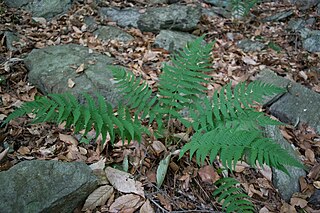
Dryopteris marginalis, vernacularly known as the marginal shield fern or marginal wood fern, is a perennial species of fern found in damp shady areas throughout eastern North America, from Texas to Minnesota and Newfoundland. It favors moderately acid to circumneutral soils in cooler areas but is fairly drought-resistant once established. In the warmer parts of its range, it is most likely to be found on north-facing non-calcareous rock faces. It is common in many altitudes throughout its range, from high ledges to rocky slopes and stream banks. Marginal wood fern's name derives from the fact that the sori are located on the margins, or edges of the leaflets.
Frond dimorphism refers to a difference in ferns between the fertile and sterile fronds. Since ferns, unlike flowering plants, bear spores on the leaf blade itself, this may affect the form of the frond itself. In some species of ferns, there is virtually no difference between the fertile and sterile fronds, such as in the genus Dryopteris, other than the mere presence of the sori, or fruit-dots, on the back of the fronds. Some other species, such as Polystichum acrostichoides, or some ferns of the genus Osmunda, feature dimorphism on a portion of the frond only. Others, such as some species of Blechnum and Woodwardia, have fertile fronds that are markedly taller than the sterile. Still others, such as Osmunda cinnamomea, or plants of the family Onocleaceae, have fertile fronds that are completely different from the sterile.
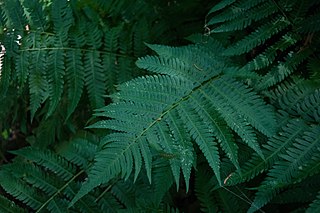
Dryopteris goldieana, commonly called Goldie's wood fern, or giant wood fern is a fern native to the eastern United States and adjacent areas of Canada, from New Brunswick to Ontario and Georgia. It is the largest native North American species of Dryopteris and along with ostrich fern it is one of the largest ferns in eastern North America. Specimens are known with fronds six feet tall. D. goldieana hybridizes with many other species of Dryopteris and the hybrids tend to be larger than the pure species. It was named by William Hooker in honor of its discoverer, John Goldie. The epithet was originally published as goldiana, but this is regarded as a misspelling to be corrected.

Asplenium trichomanes, the maidenhair spleenwort, is a small fern in the spleenwort genus Asplenium. It is a widespread and common species, occurring almost worldwide in a variety of rocky habitats. It is a variable fern with several subspecies.
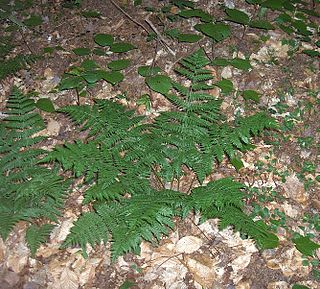
Dryopteris intermedia, the intermediate wood fern or evergreen wood fern, is a perennial, evergreen wood fern native to eastern North America. It is a diploid species, and is the parent of several species of hybrid origin, including Dryopteris carthusiana. Other common names for this species include intermediate shield fern, fancy wood fern, fancy fern, glandular wood fern, American shield fern and common wood fern.
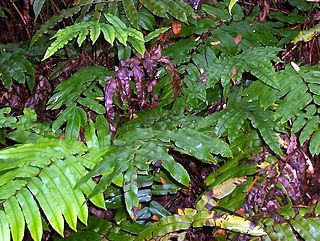
Parablechnum wattsii, synonym Blechnum wattsii, is a common terrestrial fern growing in rainforest and open forest. It is often seen near creeks in much of south eastern Australia, including Victoria, Tasmania, South Australia, New South Wales and Queensland. The specific epithet wattsii honours William Walter Watts (1856-1920). Watts was considered an authority on mosses and ferns and has more than 30 species named for him. Common names by which the species may be called are hard water fern - from its stiff leathery fronds, leech fern - as forest workers often encounter leaches while working in clusters of these ferns, hard hill fern - from the fern's habit and habitat, and red cabbage fern - from the bronze-pink colour of the young fronds resembling cooked red cabbage.

Lomaria nuda, commonly known as the fishbone waterfern, is a fern that grows up to a metre tall, and is abundant in rainforest and eucalyptus forests in eastern Australia. The species is placed in the genus Lomaria in the Pteridophyte Phylogeny Group classification of 2016, but is often retained in genus Blechnum as Blechnum nudum.

Asplenium montanum, commonly known as the mountain spleenwort, is a small fern endemic to the eastern United States. It is found primarily in the Appalachian Mountains from Vermont to Alabama, with a few isolated populations in the Ozarks and in the Ohio Valley. It grows in small crevices in sandstone cliffs with highly acid soil, where it is usually the only vascular plant occupying that ecological niche. It can be recognized by its tufts of dark blue-green, highly divided leaves. The species was first described in 1810 by the botanist Carl Ludwig Willdenow. No subspecies have been described, although a discolored and highly dissected form was reported from the Shawangunk Mountains in 1974. Asplenium montanum is a diploid member of the "Appalachian Asplenium complex," a group of spleenwort species and hybrids which have formed by reticulate evolution. Members of the complex descended from A. montanum are among the few other vascular plants that can tolerate its typical habitat.

Asplenium bradleyi, commonly known as Bradley's spleenwort or cliff spleenwort, is a rare epipetric fern of east-central North America. Named after Professor Frank Howe Bradley, who first collected it in Tennessee, it may be found infrequently throughout much of the Appalachian Mountains, the Ozarks, and the Ouachita Mountains, growing in small crevices on exposed sandstone cliffs. The species originated as a hybrid between mountain spleenwort and ebony spleenwort ; A. bradleyi originated when that sterile diploid hybrid underwent chromosome doubling to become a fertile tetraploid, a phenomenon known as allopolyploidy. Studies indicate that the present population of Bradley's spleenwort arose from several independent doublings of sterile diploid hybrids. A. bradleyi can also form sterile hybrids with several other spleenworts.

Deparia acrostichoides, commonly called silvery glade fern or silvery spleenwort, is a perennial species of fern. Its range includes much of the eastern United States and Canada, from Ontario to Nova Scotia and Georgia to Louisiana, as well as eastern Asia in China, Russia, Japan and Korea. The name silvery comes from the fact that the indusia on the underside of the leaf have a silver color when the sori are close to ripening.

Adiantum viridimontanum, commonly known as Green Mountain maidenhair fern, is a fern found only in outcrops of serpentine rock in New England and Eastern Canada. The leaf blade is cut into finger-like segments, themselves once-divided, which are borne on the outer side of a curved, dark, glossy rachis. These finger-like segments are not individual leaves, but parts of a single compound leaf. The "fingers" may be drooping or erect, depending on whether the individual fern grows in shade or sunlight. Spores are borne under false indusia at the edge of the subdivisions of the leaf, a characteristic unique to the genus Adiantum.
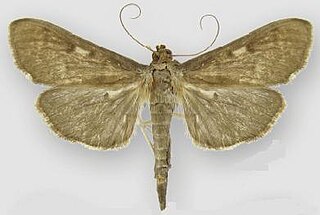
Herpetogramma sphingealis is a small species of moth in the family Crambidae. It was described as a new species in 2011.

Asplenium tutwilerae is a rare epipetric fern found only in Hale County, Alabama, United States. A. tutwilerae is a fertile allotetraploid, formed by the chromosomal doubling of a specimen of the sterile diploid A. × ebenoides, a hybrid of A. platyneuron and A. rhizophyllum. Except for its spores, which are fertile rather than malformed, A. tutwilerae is essentially identical to A. × ebenoides and was described as part of that species until 2007. It is named in honor of Julia Tutwiler, who discovered the only known wild population at Havana Glen in 1873.
Asplenium × kentuckiense, commonly known as Kentucky spleenwort, is a rare, sterile, hybrid fern. It is formed by the crossing of lobed spleenwort (A. pinnatifidum) with ebony spleenwort (A. platyneuron). Found intermittently where the parent species grow together in the eastern United States, it typically grows on sandstone cliffs, but is known from other substrates as well.



